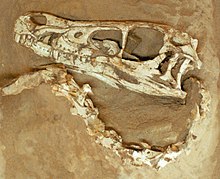Fighting Dinosaurs

The Fighting Dinosaurs is a
History of discovery

From 1963 to 1971,
The presence of the specimen on field was noted thanks to the overlapping skull fragments of the Protoceratops on the sediments, which eventually led to the excavation. It was soon nicknamed the Fighting Dinosaurs. The P. andrewsi individual is cataloged under the specimen number MPC-D 100/512 and the V. mongoliensis as MPC-D 100/25 (Mongolian Paleontological Center; originally GIN or GI SPS).[2] In 2000 the American Museum of Natural History organized the traveling exhibit Fighting Dinosaurs: New Discoveries from Mongolia which was mainly focused on important Mongolian fossils with emphasis on the Fighting Dinosaurs, which is now regarded as a national treasure of Mongolia.[3]
Interpretation

In 1974, Mongolian paleontologist
In 1995, David M. Unwin and colleagues argued that scavenging was unlikely as there were numerous indications of a simultaneous death. The Protoceratops has a semi-erect stance and its

In 1998,

In 2016 Barsbold reported several anomalies within the Protoceratops individual: both
See also
References
- ^ Kielan-Jaworowska, Z.; Barsbold, R. (1972). "Narrative of the Polish-Mongolian Palaeontological Expeditions, 1967-1971" (PDF). Palaeontologia Polonica. 27: 1−12.
- ^ a b Carpenter, K. (1998). "Evidence of predatory behavior by carnivorous dinosaurs" (PDF). Gaia. 15: 135−144.
- ^ "Fighting Dinos". AMNH. American Museum of National History. 2000.
- ^ Barsbold, R. (1974). "Поединок динозавров" [Dueling dinosaurs]. Priroda (in Russian). 2: 81−83.
- ^ Osmólska, H. (1993). "Were the Mongolian Fighting Dinosaurs really fighting?". Rev. Paleobiol. 7: 161−162.
- .
- S2CID 90811750.
External links
 Media related to Fighting Dinosaurs at Wikimedia Commons
Media related to Fighting Dinosaurs at Wikimedia Commons- Reconstructed Fighting Dinosaurs at ArtStation
- 3D model of the Fighting Dinosaurs specimen at Sketchfab
